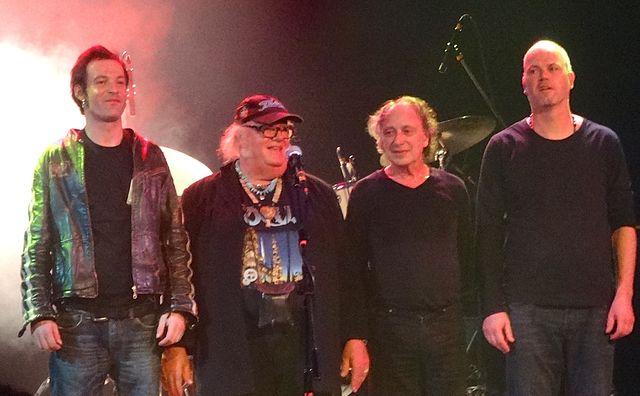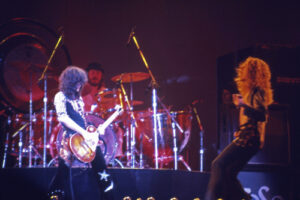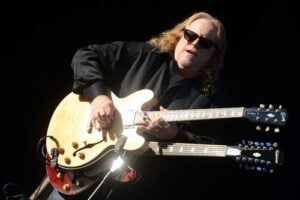
Licensed from Shutterstock
Rock music, often synonymous with power, rebellion, and volume, has also long been a genre capable of evoking something far more elusive: the ethereal. In its purest sense, ethereal describes that which feels otherworldly—delicate, intangible, and emotionally suspended above the ordinary. In rock music, this can manifest through a spectral vocal delivery, an ambient arrangement, a slow drift in tempo, or lyrics that conjure memory, dream, or spiritual dislocation. Sometimes it’s created through sheer sonic atmosphere; other times, it’s found in a single, weightless phrase that hangs in the air long after the song ends. This list explores ten songs that didn’t just lean into that feeling—they embodied it, offering listeners an escape into soundscapes where time folds and emotion breathes in slow motion.
Yes constructed vast architectural sound journeys where melody and philosophy climbed side by side toward transcendence, while Pink Floyd, ever the masters of sonic space, used restraint, echo, and narrative to explore emotional distance on a planetary scale. David Bowie turned a tale of space exploration into a metaphor for isolation, transforming silence and static into poetry, and Radiohead blurred the boundaries between consciousness and confusion, surrendering melody to mood in favor of surreal psychological drift. The Moody Blues wove orchestration and Mellotron into romantic longing, creating a song that floats endlessly on melancholy, while Tangerine Dream did not merely compose songs—they designed audio environments, with “Stratosfear” unfolding like a lucid dream rendered in analog circuitry.
Brian Eno distilled ambient music to its most essential elements, letting stillness, tone, and decay do the work of narrative, and Led Zeppelin explored the darker end of the ethereal spectrum, crafting a track that used slowness and myth to summon the cold space between dimensions. The Beatles conjured a childhood memory into surreal abstraction, allowing tape loops, disjointed arrangements, and lyrical ambiguity to merge into reverie, and Simon & Garfunkel, in a hushed invocation, gave silence itself a voice, closing this list with a song that lingers like a ghost in the walls of modern life.
Together, these ten tracks form a constellation of rock’s most spectral moments—proof that the genre’s power doesn’t always come from volume or velocity. Sometimes, it’s found in what’s barely there at all.
# 10 – Nights in White Satin – The Moody Blues
Recorded between October 1966 and March 1967 at Decca Studios in London, “Nights in White Satin” was composed by Justin Hayward and served as the closing track on Days of Future Passed, the Moody Blues’ groundbreaking second album. The song was produced by Tony Clarke, with orchestral arrangements conducted by Peter Knight and performed by the London Festival Orchestra, creating a fusion of symphonic classical music and progressive rock. The lineup for the recording featured Justin Hayward on lead vocals and acoustic guitar, John Lodge on bass, Mike Pinder on Mellotron and piano, Ray Thomas on flute and backing vocals, and Graeme Edge on drums. Its initial release as a single in 1967 saw moderate success, but a 1972 reissue brought it to wider acclaim, reaching No. 2 on the Billboard Hot 100 and No. 9 on the UK Singles Chart.
Read More: An Interview With John Lodge Of The Moody Blues
# 9 – In Limbo – Radiohead
“In Limbo” was recorded by Radiohead for their fourth studio album, Kid A, which was released on October 2, 2000, in the United Kingdom and a day later in the United States. The album was produced by longtime collaborator Nigel Godrich and the band, and the sessions took place at several locations, including Guillaume Tell Studios in Paris, Medley Studios in Copenhagen, and the band’s own studio in Oxfordshire. The lineup for the recording consisted of Thom Yorke on vocals and guitar, Jonny Greenwood on keyboards and effects, Ed O’Brien on guitar and backing vocals, Colin Greenwood on bass, and Phil Selway on drums and percussion. “In Limbo” was not released as a single, but its placement on Kid A served as a disorienting midpoint in an album that deliberately distanced itself from conventional rock structure.
Read More:Complete List Of Radiohead Songs From A to Z
# 8 – No Quarter – Led Zeppelin
With “No Quarter,” Led Zeppelin retreated from the thunderous force that defined much of their early work and instead constructed a slow-moving, immersive soundscape that felt suspended in some half-lit, dreamlike realm. The track was recorded during the sessions for Houses of the Holy, which took place in 1972 at both Stargroves in Hampshire and Olympic Studios in London. Produced by Jimmy Page and engineered by Eddie Kramer, the recording featured Robert Plant on vocals, John Bonham on drums, Jimmy Page on guitar, and John Paul Jones at the center of the arrangement, performing both electric piano and synthesizers. The track’s final form was shaped by deliberate manipulation—tape speed was slowed, creating a thick, sluggish atmosphere where every note seemed to linger in a fog.
Read More: Complete List Of Led Zeppelin Songs From A to Z
# 7 – Stratosfear – Tangerine Dream
Tangerine Dream didn’t just flirt with ethereal soundscapes—they defined the terrain. Had this list aimed to represent just one group, it could easily have been comprised entirely of their work. “Stratosfear,” the title track from their 1976 album Stratosfear, was recorded by the trio of Edgar Froese, Christopher Franke, and Peter Baumann. The album was produced by Tangerine Dream themselves and recorded at Audio Studios in Berlin. Released by Virgin Records, it marked the band’s continued evolution from the analog sequencer-based minimalism of their earlier work into something more melodic, structured, and texturally rich—without sacrificing their commitment to sonic atmosphere.
“Stratosfear” unfolded over ten minutes and thirty-five seconds of shifting moods and electronic textures, combining modular synthesizers with acoustic piano, Mellotron, and electric guitar. Unlike the more abstract constructions of Phaedra or Rubycon, this composition introduced recurring themes and motifs, including a central descending melodic figure that floated through various instrumental voicings. The piece opened with sequenced pulses and ambient winds before slowly blooming into a cyclical melody that seemed to breathe. Franke’s sequencer patterns formed the foundation, while Froese added guitar flourishes and Baumann contributed the synth washes that gave the piece its immersive depth. The result was a sonic environment that never settled, yet felt meditative and suspended—like drifting through layers of sky that never fully solidified into form.
Read More: Top 10 Tangerine Dream Songs
# 6 – Close To The Edge – Yes
Composed and recorded in the spring and summer of 1972, “Close to the Edge” occupied the entire first side of Yes’s fifth studio album, Close to the Edge, released on September 13 of that year. The sessions took place at Advision Studios in London and were co-produced by the band and Eddie Offord. The lineup featured Jon Anderson on vocals, Steve Howe on guitars, Chris Squire on bass, Rick Wakeman on keyboards, and Bill Bruford on drums. This would be Bruford’s final studio recording with the band before his departure to King Crimson. Spanning eighteen minutes and forty-three seconds, the track was structured in four continuous sections—“The Solid Time of Change,” “Total Mass Retain,” “I Get Up I Get Down,” and “Seasons of Man”—each moving through complex shifts in tempo, texture, and harmonic development.
The song’s opening—a jagged, atonal collage of guitar fragments, keyboard runs, and field-recorded nature sounds—set a disorienting tone before launching into one of the most intricate progressive rock arrangements of the era. Wakeman’s Mellotron and church organ passages provided the track’s most ethereal moments, particularly during the “I Get Up I Get Down” section, where Anderson and Howe’s harmonized vocals floated over slowly rising synth pads and cathedral-like ambiance. Unlike the spatial melancholy of “Strawberry Fields Forever” or the ambient desolation of Tangerine Dream’s “Stratosfear,” “Close to the Edge” achieved its dreamlike state not through minimalism, but through maximalist layering—blending classical motifs, jazz-fusion rhythms, and shifting time signatures into a single, immersive experience.
Read More: Complete List Of Yes Studio Albums And Songs
# 5 – An Ending (Ascent) Brian Eno
Brian Eno recorded “An Ending (Ascent)” in 1983 as part of the soundtrack album Apollo: Atmospheres and Soundtracks, a collaboration with his brother Roger Eno and producer Daniel Lanois. The album was conceived as a sonic accompaniment to For All Mankind, the 1989 documentary film compiled from NASA’s Apollo space mission footage. Sessions for the album took place at Grant Avenue Studio in Hamilton, Ontario, with Lanois engineering and contributing pedal steel guitar and processing. Eno handled the majority of the synthesizer arrangements, sound design, and production, crafting ambient textures specifically designed to evoke the silence and immensity of outer space. Though “An Ending (Ascent)” was never released as a single, it became one of Eno’s most widely recognized compositions, frequently used in films, television, and commemorative events.
Read More: Top 10 Brian Eno Songs
# 4 – Strawberry Fields Forever- The Beatles
The earliest sessions for “Strawberry Fields Forever” began on November 24, 1966, at EMI Studios in London, making it the first song recorded for what would become Sgt. Pepper’s Lonely Hearts Club Band, though it was ultimately released as a non-album single. Produced by George Martin, the song featured John Lennon on lead vocals, Mellotron, and acoustic guitar; Paul McCartney on bass and piano; George Harrison on slide guitar and swarmandal; and Ringo Starr on drums and percussion. After weeks of experimentation—including multiple takes in radically different arrangements—Martin famously fused two versions of the track into one by adjusting the pitch and speed of the recordings, resulting in a final product that felt hypnotic, disorienting, and otherworldly. Released in February 1967 as a double A-side with “Penny Lane,” the single peaked at No. 2 in the UK and No. 8 on the Billboard Hot 100.
Read More: Complete List Of The Beatles Songs From A to Z
# 3 – Us And Them – Pink Floyd
“Us and Them” was recorded between June 1972 and January 1973 at Abbey Road Studios in London for Pink Floyd’s The Dark Side of the Moon, released on March 1, 1973. The track was produced by the band alongside longtime engineer Alan Parsons, who played a key role in the album’s spatial dynamics and sonic clarity. Richard Wright composed the original chord progression on piano during the Zabriskie Point sessions in 1969, and Roger Waters later added lyrics reflecting themes of war, social division, and alienation. The lineup for the recording featured David Gilmour on lead vocals and guitar, Wright on piano and Hammond organ, Waters on bass, and Nick Mason on drums. Session saxophonist Dick Parry contributed the track’s signature solos, and background vocals were provided by Doris Troy, Lesley Duncan, Liza Strike, and Barry St. John.
Though not initially released as a single in the UK, “Us and Them” was issued as a single in the United States in 1974, reaching No. 72 on the Billboard Hot 100. More significantly, the track became one of the emotional and atmospheric anchors of The Dark Side of the Moon, an album that spent over 950 weeks on the Billboard 200 and remains one of the most critically acclaimed records in history. “Us and Them” was regularly performed during Pink Floyd’s 1970s tours and has been featured on multiple live releases, including Pulse and Delicate Sound of Thunder.
Read More: 25 Classic Pink Floyd Songs Everyone Should Know
# 2 – Space Oddity – David Bowie
Read More: Complete List Of David Bowie Songs From A to Z
# 1 – The Sound Of Silence – Simon & Garfunkel
“The Sound of Silence” was originally recorded by Simon & Garfunkel on March 10, 1964, at Columbia Studios in New York City, produced by Tom Wilson. The initial version appeared on their debut album Wednesday Morning, 3 A.M., and featured only Paul Simon on acoustic guitar and both Simon and Art Garfunkel on vocals. That release failed to gain commercial traction, prompting the duo to briefly split. In 1965, without Simon and Garfunkel’s knowledge, Wilson added electric guitar, bass, and drums to the original recording, transforming it into a folk-rock arrangement using session musicians including Al Gorgoni and Bobby Gregg. This new version was released as a single in September 1965, and by January 1, 1966, it had reached No. 1 on the Billboard Hot 100, launching the duo’s mainstream career.
Read More: Complete List Of Simon & Garfunkel Songs From A to Z
Check out similar articles on ClassicRockHistory.com Just click on any of the links below……
Read More: Artists’ Interviews Directory At ClassicRockHistory.com
Read More: Classic Rock Bands List And Directory
Updated August 6, 2025



































